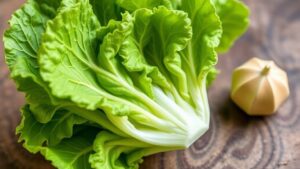Lettuce offers some calcium, but not as much as other leafy greens. Bibb lettuce provides about 19.3 mg per cup, while Romaine has 15.5 mg and Iceberg only 9.45 mg per serving. Though these amounts seem small, choosing darker varieties like Bibb or Romaine can add up over time. However, relying solely on lettuce for calcium isn’t practical—other greens pack far more. Comprehending how lettuce stacks up helps make smarter choices for bone health.
Calcium Content in Different Types of Lettuce
Different types of lettuce offer varying amounts of calcium, with some varieties providing noticeably more than others. Bibb lettuce, for example, contains 19.3 mg of calcium per cup, making it one of the higher-calcium options. Romaine lettuce follows with 15.5 mg per cup, while iceberg lettuce has drastically less, at just 9.45 mg per 35-gram serving. These differences highlight how choosing the right variety can impact calcium intake.
Though lettuce isn’t the wealthiest source of calcium, knowledge of these variations helps in making informed dietary choices. For those prioritizing calcium, selecting Bibb or Romaine over iceberg may provide slight benefits. The calcium content in lettuce still falls short compared to other leafy greens, but it’s a versatile option for adding nutrients to meals.
Comparing Lettuce to Other Leafy Greens for Calcium
Raw kale delivers about 90.5 mg of calcium per cup, nearly six times more than Romaine lettuce. While lettuces like Romaine, Bibb, and iceberg provide small amounts of calcium, other leafy greens outperform them substantially.
Collard greens offer 52.2 mg per cup, and bok choy packs 73.5 mg, making them stronger calcium sources. Spinach and Swiss chard contain higher calcium levels but also more oxalates, which might restrict absorption. Cooking these greens can reduce oxalates, enhancing calcium availability.
For those seeking calcium-rich options, darker, sturdier greens like kale or collards are preferable choices than typical lettuces. Though lettuce contributes some calcium, its low density means relying on it alone won’t satisfy daily needs. Combining various greens guarantees a more balanced intake.
Factors Affecting Calcium Absorption From Lettuce
While lettuce supplies some calcium, what actually gets absorbed by the body depends on several factors. Lettuce varieties like romaine and bibb contain more calcium than iceberg, but oxalates in some greens can bind calcium, reducing absorption. Cooking can lower oxalate levels, improving bioavailability.
A person’s overall diet also matters—calcium absorption improves when paired with vitamin D sources. Stomach acidity affects uptake, too, as higher acid levels help release calcium from food. Some medications or digestive issues might interfere, so it’s wise to consult a healthcare provider. Privacy policy protections don’t directly impact calcium absorption, but privacy matters when discussing personal health details with professionals.
Eating a variety of leafy greens guarantees better calcium intake over time.
Daily Calcium Needs and Lettuce Consumption
Lettuce contributes a small amount of calcium, but meeting daily requirements takes more than just a salad. Adults typically need 1,000–1,200 mg of calcium daily, yet a cup of iceberg lettuce provides only about 16 mg—far below what’s needed. While romaine offers slightly more (15.5 mg per cup), relying solely on lettuce won’t cut it.
Portion reality: Eating 10 cups of iceberg lettuce would barely cover 16% of daily calcium needs.
Variety matters: Darker greens like kale pack more calcium (90–266 mg per cup).
Absorption factors: Lettuce’s calcium isn’t as easily absorbed as dairy or fortified foods.
Balanced approach: Pairing lettuce with other calcium-rich foods helps close the gap.
For those prioritizing calcium, lettuce is a start—but just a small piece of the puzzle.
Healthier Calcium-Rich Alternatives to Lettuce
For those looking to boost their calcium intake beyond lettuce, plenty of nutrient-packed alternatives offer a much bigger payoff. Leafy greens like kale, collard greens, and bok choy provide over 70 mg per cup, while romaine lettuce contains just 15 mg. Non-dairy options like almonds, tofu, and sesame seeds are excellent for those avoiding dairy. Legumes such as chickpeas deliver 80 mg per 80 g serving, and seaweed like wakame packs 150 mg per 100 g. Including these foods helps better calcium absorption and fulfills daily needs.
| Food | Calcium (per serving) | Serving Size |
|---|---|---|
| Kale | 70 mg | 1 cup |
| Almonds | 75 mg | 1 oz |
| Chickpeas | 80 mg | 80 g |
| Wakame | 150 mg | 100 g |
All rights reserved to factual nutritional data.


